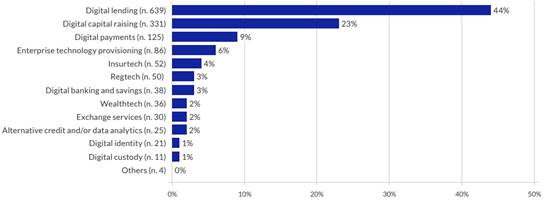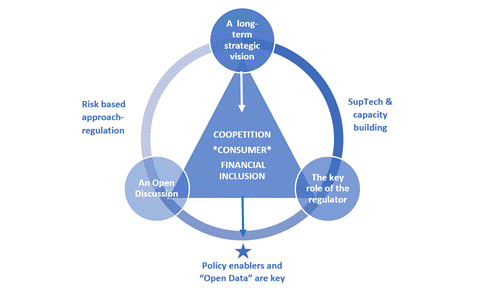The FinTech context
The incursion of institutions that seek to develop technological improvements in the financial sector (FinTech) has grown at a great speed around the world. Globally, FinTech has expanded in scope, now covering the full spectrum of finance and financial services.
In conformity to the Financial Stability Board1, FinTech is the technology-enabled financial innovation that could lead to new business models, applications, processes, or products with an associated material effect on financial markets, institutions, and the provision of financial services.
As explained in the taxonomy developed by the jointly effort of the Cambridge Center for Alternative Finance, the World Bank, and the World Economic Forum in 20222, the FinTech activities can be allocated into 12 verticals: digital lending, digital capital raising, digital banks and/or savings, digital payments, exchange services, digital custody, insurtech, wealthtech, regtech and/or suptech, alternative credit and/or data analytics, digital identity and enterprise technology provisioning. The following figure presents a sample of the composition of these verticals around the world.

Source: Cambridge Center for Alternative Finance, the World Bank, and the World Economic Forum (2022)
Figure 1 Global survey sample: composition according to primary fintech vertical (total number, percentage of total)
In the case of Costa Rica, there has been an increase of this type of FinTech companies in the recent years. According to the latest data that the Misión Lunar initiative has compiled in their radar3, as of February, 2023, there are at least 61 FinTech related enterprises in the country, this number contrast to the identification of 25 FinTech players made by the IADB and Finnovista report4 in 2019, representing a growth of around 144% during that period.
As part of the ecosystem it is important to mention that there are in the country other related participants, for example the Asociación Fintech de Centroamérica y el Caribe, the Asociación Blockchain de Costa Rica , the Capítulo FinTech of the Cámara de Tecnologías de Información y Comunicación (CAMTIC), the Centro de Innovación Financiera (CIF), private labs and accelerators, academia, and innovation teams within regulated financial entities.
In accordance to the IADB and Finnovista report in 2019, and the more recent report of the Promotora de Comercio Exterior de Costa Rica (Procomer) in 20225 regarding FinTech in Costa Rica, the country has good conditions and a positive outlook for the evolution of FinTech companies, but the funding mechanisms are one of its weaknesses. They also pointed to the need of regulation that can allow to have legal certainty for the projects and initiatives.
Finally, it is relevant to highlight that Costa Rica has made significant efforts to expand banking services for the population, and indicators point to a high level of financial inclusion for individuals; in this country more than 80% of adults have an account in a financial institution, which is above the average for Latin America and the Caribbean; and there is a national payment system that is efficient and secure that has achieved many innovation milestones for the country during the last two decades. With that in mind, when thinking about FinTech, the main challenges come not too much with bancarization, but with the level of competition, use and deepness of the new technologies in the market, that allow us to reach higher and better levels of inclusion and wellbeing of financial consumers.
The importance of a regulatory framework for FinTech
The market size is a good indicator to see when an industry is big enough to begin to be more relevant to the regulator6. According to the CFA Institute Research Foundation7, the stages for company growth and the relation with the regulatory supervision can be shown in the following figure.
In this regard, it is always important for a country to be aware of the FinTech movement, because it presents an exponential growth behavior, so this condition limits the ability to predict the moment in which they will be too large to ignore.
On the one hand, the development of a regulatory framework for FinTech is important to mitigate risks related to the financial stability and consumer protection. And on the other hand, the regulation is also necessary because it is understood that the FinTech firms have the natural intention to solve market failures and provide a faster and better financial service, and then, there are opportunities to increase the efficiency and competition of the financial system with regulations that allow this to happen. At the end, financial inclusion should be at the heart of this whole issue.
The FinTech roadmap of the supervisors and regulators in Costa Rica
In the case of Costa Rica, at the beginning, the approach consisted of having a vigilant attitude from the regulator side, always with the intention of letting innovation flourish by having some degrees of tolerance in tandem with a surveillance of the industry.
With that in mind, and with the intention of integrating efforts to develop a common FinTech agenda within the four Superintendencies, the National Council for Supervision of the Financial System, and the Central Bank of Costa Rica, a FinTech Working Group was created in 2019.
This group begin to study the concepts around FinTech, communicate with national and international stakeholders, participate in working groups, workshops and studies related the topic, and with that, a roadmap was design; considering not only the stage of the FinTech industry but also the particularities of this country (see the box below). The roadmap recommended by the group in 2020, included8:
FinTech Working Group: continuation of the group's work, maintaining synergies, deepening coordination, expanding knowledge, improving capacities, and strengthening cooperation between the entities represented in the group.
FinTech Innovation Hub: creation in the system of regulation and financial supervision a space for communication, orientation, and knowledge of the FinTech industry. This hub has named by his translation to Spanish as Centro de Innovación Financiera (CIF).
Legal and regulatory reforms regarding FinTech: aiming to face the challenges that the FinTech phenomenon can impose into the regulatory system and financial supervision, with a modern approach based on activities and proportionally.
The first two points of the roadmap are already implemented, and the last one can be seen, as a third step that nowadays is under analysis, to consider the approach, need and opportunity to perform regulatory adjustments.
What is the Centro de Innovación Financiera (CIF)?
The CIF is a space for dialogue and consultation between those who wish to develop technological innovation initiatives in financial products or services and the regulatory and supervisory entities of the Costa Rican financial system. It is made up of a group of experts in different disciplines, created with the purpose of clarifying and guiding financial innovators in the process of developing and inserting their initiative within the framework of financial regulation.
The objective is to facilitate dialogue and exchange of information between financial regulation and supervision entities and initiatives for technological innovations in financial products or services, to ensure their development in accordance with the regulation of the financial sector and, at the same time, identify needs for possible improvements and regulatory changes related to financial innovation for the benefit of Costa Ricans. The CIF seeks to collaborate in the improvement of:
Efficiency, competitiveness, and transparency of the financial sector.
Financial inclusion
Financial stability.
Financial consumer protection.
On April 2022, this center was launched and from that time to now, the team has been addressing the queries submitted by the innovators, having meetings with them, designing and implementing a communication plan and making connections with key stakeholders.
The main task of the center is the one related to attending the innovators, as indicated in figure 5. The practice is to always have a virtual meeting with the innovators to understand the project or initiative, and to can give the required advice and guidance. In this part is important to highlight that all the answers and information that the CIF gives to the innovators is not binding and, in the cases, where the proposed activities or projects have already a regulation in place, the CIF provides the information and guidance required to direct the innovator to the respective regulator in charge.

Source: Centro de Innovación Financiera, Costa Rica.
Figure 5 The process of attending innovators at CIF
The other important task of the center is the one related to the internal work. In this regard, the center serves to identify regulatory barriers or strengths and communicate the authorities the situation to help them to decide where the needs are for changes or improvements in the regulation regarding FinTech.
According to the Annual Memory of the Central Bank of Costa Rica10, during the first months of operation of the CIF, benefits were observed in accordance with the objectives initially set, for example:
Generates data on the type of business models and operation of the FinTech initiatives that are being developed in the country.
Serves the financial innovator as a guide for the respective registration processes, as well as understand the current regulatory framework.
Identifies needs and priorities for the generation of new regulation and opportunities for improvements in the current regulation.
Promotes the unification of vision and criteria of the entities of supervision and regulation in FinTech issues.
Research and stay up to date on financial and technological innovations that are carried out internationally, to identify risks and opportunities.
Promotes cooperation with national and international organizations in these topics.
At the end, the CIF can be seen as an innovation facilitator and an evolving initiative that will transform over time as it meets its objectives.
A vision for the future
This section proposes some key elements that can help to build a fintech national strategy framed within a more general financial inclusion strategy in the country, it aims to create the environment for the digital transformation of the financial system in the country that at the end will be traduced in higher levels of inclusion and wellbeing of the population, while decreasing excessive risks.
The model going forward should be one that seeks to foster innovation and competition while preserving consumer protection and market stability. The idea presented here for Costa Rica is for the regulator to leverage on the knowledge and level of advance in their FinTech strategy, to put all the required elements together and facilitate the movement.

Source: Author's analysis
Figure 5 Elements of a possible FinTech strategy: fostering financial inclusion through digital transformation of the financial system in Costa Rica
1. Strategic long-term view: It is crucial to think strategically and avoid adopting an approach without having an overarching long-term view of where financial innovation should be focus-on when prioritizing efforts. At the end, to foster financial inclusion, a collaborative attitude will be needed, and the consumer will be at the center.
2. The key role of the regulator. The regulator needs to adopt a proactive attitude towards innovation that will help them not only to better overcome current challenges but also to anticipate future changes while decreasing excessive risks. It is understood that today the financial authorities must overcome so many other issues, however, to give a step forward technological change needs to be of a key relevance in these times. Here are some reasons why this approach is desired:
Regulators have convening power, so they can convene the parties and promote discussions and worktables towards common objectives.
There is a solid base within the Superintendencies, the National Council for Supervision of the Financial System, and the Central Bank of Costa Rica, studying and building capacity in this topic since 2019, specially with the promising and newly created Centro de Innovación Financiera (CIF).
Coordinating the movement can assure the involvement of the regulator since the beginning of the transformation process, which is an advantage in the sense that open the possibility to collaborate in the design and implementation of the future of the financial system in the country.
It also can be useful to foster innovation and competitiveness within the country, that can benefit the population in terms of inclusion and the provision of faster and better financial services.
There are also experience in place in leading and coordinating national financial strategies in the country, for example, the case of the development of the National Payment System (SINPE)11 which is led by the Central Bank of Costa Rica. (See the box below).
Today there are examples of other central banks and financial regulators leading and coordinating national strategies related to FinTech that can be used to learn and improve (see for example cases in Colombia, Brazil, or Singapore).
3. An open discussion: There is a need to understand the technologies and business models that can be applied in the FinTech arena, and that is why collaboration and mutual learning must be at the top of the process. Understanding and monitoring these types of developments could be done through closer engagement with industry players (national and international), including currently unregulated FinTech firms, regulated financial institutions and international organizations. In this regard, the CIF is a key element for making these conversations happen.
4. A parallel development of SupTech & Digital Transformation: The regulator roadmap for regulating this revolution must be done in the frame of a parallel approach. It is not limited to create the regulation for FinTech companies: it needs to also include the utilization of the technology in its advantage.
The new era in supervision and regulation is framed in the use and combination of many technologies. This means that the regulator must be aware of how the introduction of RegTech (Reg for regulatory) could transform regulatory compliance and risk management for financial institutions, while also how SupTech (Sup for supervisory) could be used to increase supervisory effectiveness and efficiency. There is a need for a focus on improving data governance and management within all the financial sector in the frame of this digital transformation journey.
Furthermore, building capacity and knowledge in topics such as digital assets, tokenization and programable money will be also key. There is a need to understand the challenges and opportunities that new technologies impose to the financial system and to be ready to experiment and take advantage of that.
5. Policy enablers and Open Data are key: Apart from regulation and financing for entrepreneurs, there are other challenges that need to be handle at a national level. In this regard there are many policy enablers that need to be developed in coordination within the respective governmental agencies that have a task to perform on that as part of the National Digital Transformation Strategy. For example:
Digital Identity
Financial and Digital Literacy
Internet coverage
Open Finance
Cybersecurity
Data Protection
Development of digital capabilities
This idea is well represented in the following ''FinTech Tree: a taxonomy of the fintech environment'' of the Bank for International Settlements (BIS)12, where all these aspects act as the bases or roots of the tree.
6. Risk based approach: In general, it is important to focus on the financial processes that technology enables and understanding where the different risks are. Defining regulation by activity and in a proportional manner will be key in this regard.
Finally, all the elements that where described need to be framed in an environment that will push collaboration & competition in a sustainable and healthy way among the participants.
On the one hand, the banks and traditional regulated financial institutions are the ones that have the customers, licenses, and the experience in banking and financial markets; and on the other hand, the start-ups can provide fresh new ideas, new technologies and skills. An alliance between the two can increase the probabilities for the former to accelerate their digital transformation and for the latter to subsist.
Coopetition will be key to let parties focus on competition where the company have more advantages for a market segment, and on collaboration in the segments and topics that can enhance the efficiency of the financial system and foster financial inclusion for the good of the Costa Ricans.























